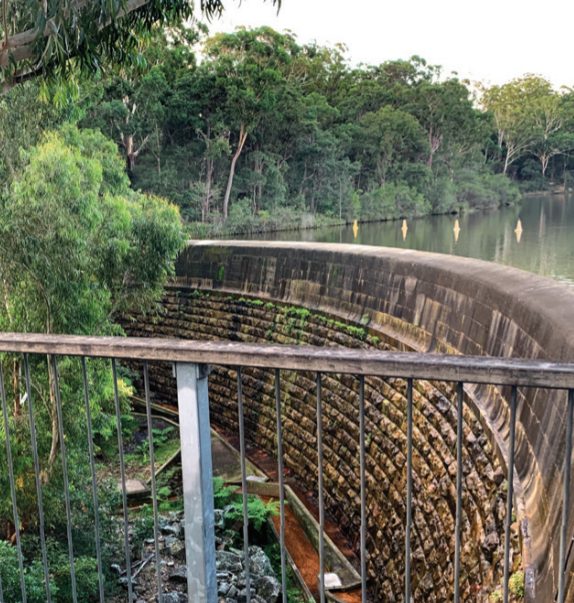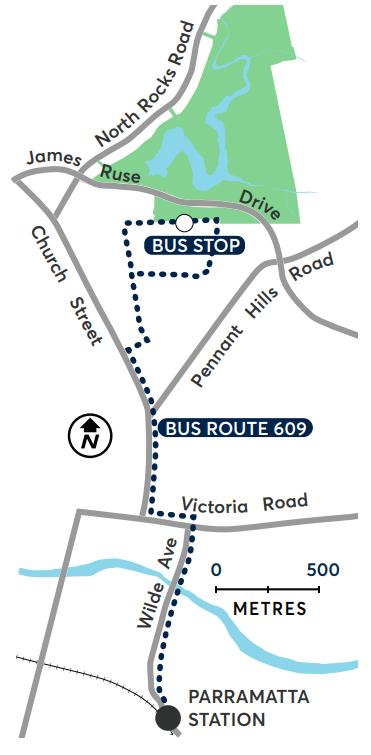Welcome to Country. The traditional custodians of Lake Parramatta Reserve are peoples of the Burramatagal clan of the Dharug language group. Some relics of Aboriginal occupation exist on site in the form of remnant shelters, hand-stencils, flaking scars and midden deposits. Today we welcome you to the reserve and ask that you acknowledge indigenous cultural values particularly having respect for Earth and all its creatures.
Completed in 1856, the Lake Parramatta reservoir was the first large dam built in Australia. It was made of sandstone blocks quarried onsite as seen today from the Dam Wall Lookout.

A concrete rim adding 3.3m to the dam height was built in 1898. The dam was a crucial part of Parramatta’s water supply until 1909, when the city was connected to Sydney’s water system (following the construction of the Cataract Dam).
An enduring legacy of the dam for Parramatta was the creation of a water reserve protecting its catchment in the 1880s. This was later expanded to cover the natural area now protected in Lake Parramatta Reserve.
Today the reserve forms a vital part of a connected network of natural areas. These provide essential habitat for an array of native wildlife across the Parramatta River Catchment. Please help to protect these values by following the reserve’s user regulations.
Lake Parramatta is one of the most significant and beautiful bushland remnants in Western Sydney. It features picnic and BBQ facilities, playground, kiosk and bushwalking tracks. The main entrance is from Lackey Street off Bourke Street in North Parramatta, with entry gates opening at 6.30am and closing at 5.30pm (7.30pm during daylight savings). Parking by the lake is limited. Overeflow parking is available beside Bourke St entrance.
Lake Parramatta Reserve is the largest surviving bushland remnant in the Parramatta Local Government Area and has the highest diversity of native flora and fauna.
To protect these unique native animals and their habitats, Lake Parramatta Rerserve has been proclaimed as a Wildlife Refuge under the National Parks and Wildlife Protection Area under the Companion Animals Act 1998. Cats are prohibited from entering the reserve and dogs must be on a lead and remain on established tracks.
HERITAGE PATH Grade 1: 300m one way
Follow the surfaced wheelchair assisted accessible path around from the visitor hub to the Dam Wall Lookout. Short steeper ‘wheelchair assistance required’ sections occur.
ARRUNGA BARDO WALK Grade 2: 900m one way
Starting from the Arrunga Bardo Garden follow the evenly surfaced bushtrack past Lake Parramatta’s finest views to the Arrunga Bardo (Calm Waters) Lookout.
RESERVOIR TRACK Grade 3: 600m one way
Steep steps, a creek crossing and rocky track surfaces make this a grade 3 outing to a fine viewpoint.
UPPER LAKE TRACK Grade 3: 2100m one way
Connects Reservoir Lookout with Arrunga Bardo (Still Waters) Lookout via the top of the lake.
LAKE CIRCUIT Grade 3: 4200m loop / 2 hrs
Link the Heritage Path, Arrunga Bardo, Reservoir Track and Upper Lake Track together for a memorable lap of the lake.
Regulations and Cautions
Please be aware that the Upper and Lower Hunts Creek Crossings of the track network may be impassable during and after light to heavy rain events. Do not use Lake Circuit when water is flowing over stepping stones at creek crossings.
Dogs are to be kept on leads at all times and cats are not allowed in the reserve at all.
No bicycles are allowed on walking tracks. Bicycles are permitted on Illawong Drive and sections of the Management Trail in eastern parts of the reserve.
Swimming is not advised in areas other than visitor hub designated area.







